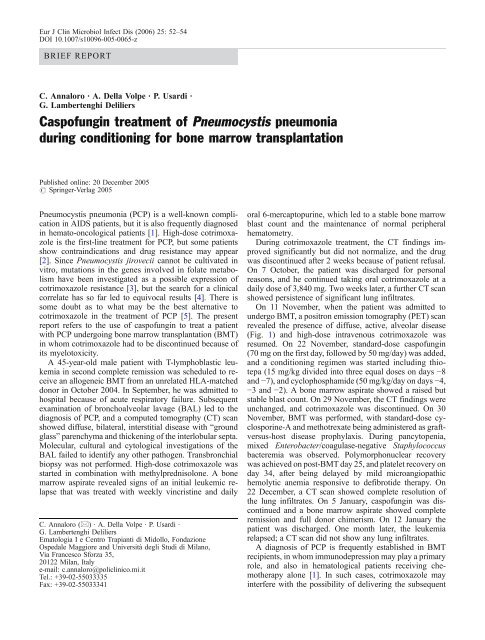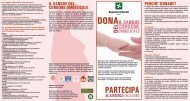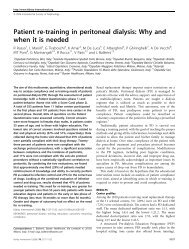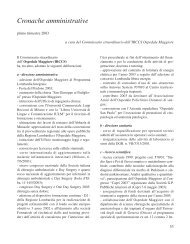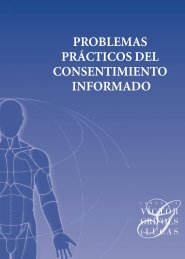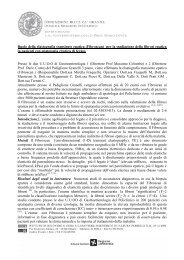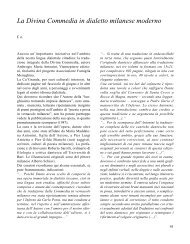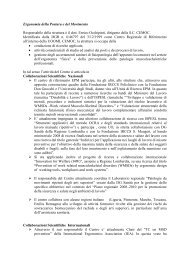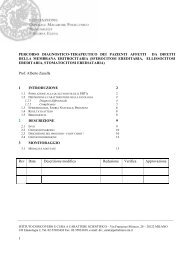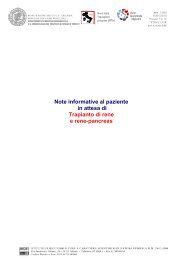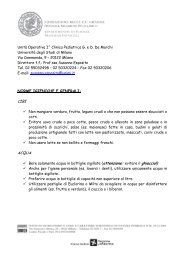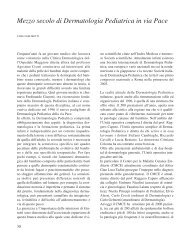Caspofungin treatment of Pneumocystis pneumonia during ...
Caspofungin treatment of Pneumocystis pneumonia during ...
Caspofungin treatment of Pneumocystis pneumonia during ...
Create successful ePaper yourself
Turn your PDF publications into a flip-book with our unique Google optimized e-Paper software.
Eur J Clin Microbiol Infect Dis (2006) 25: 52–54<br />
DOI 10.1007/s10096-005-0065-z<br />
BRIEF REPORT<br />
C. Annaloro . A. Della Volpe . P. Usardi .<br />
G. Lambertenghi Deliliers<br />
<strong>Casp<strong>of</strong>ungin</strong> <strong>treatment</strong> <strong>of</strong> <strong>Pneumocystis</strong> <strong>pneumonia</strong><br />
<strong>during</strong> conditioning for bone marrow transplantation<br />
Published online: 20 December 2005<br />
# Springer-Verlag 2005<br />
<strong>Pneumocystis</strong> <strong>pneumonia</strong> (PCP) is a well-known complication<br />
in AIDS patients, but it is also frequently diagnosed<br />
in hemato-oncological patients [1]. High-dose cotrimoxazole<br />
is the first-line <strong>treatment</strong> for PCP, but some patients<br />
show contraindications and drug resistance may appear<br />
[2]. Since <strong>Pneumocystis</strong> jirovecii cannot be cultivated in<br />
vitro, mutations in the genes involved in folate metabolism<br />
have been investigated as a possible expression <strong>of</strong><br />
cotrimoxazole resistance [3], but the search for a clinical<br />
correlate has so far led to equivocal results [4]. There is<br />
some doubt as to what may be the best alternative to<br />
cotrimoxazole in the <strong>treatment</strong> <strong>of</strong> PCP [5]. The present<br />
report refers to the use <strong>of</strong> casp<strong>of</strong>ungin to treat a patient<br />
with PCP undergoing bone marrow transplantation (BMT)<br />
in whom cotrimoxazole had to be discontinued because <strong>of</strong><br />
its myelotoxicity.<br />
A 45-year-old male patient with T-lymphoblastic leukemia<br />
in second complete remission was scheduled to receive<br />
an allogeneic BMT from an unrelated HLA-matched<br />
donor in October 2004. In September, he was admitted to<br />
hospital because <strong>of</strong> acute respiratory failure. Subsequent<br />
examination <strong>of</strong> bronchoalveolar lavage (BAL) led to the<br />
diagnosis <strong>of</strong> PCP, and a computed tomography (CT) scan<br />
showed diffuse, bilateral, interstitial disease with “ground<br />
glass” parenchyma and thickening <strong>of</strong> the interlobular septa.<br />
Molecular, cultural and cytological investigations <strong>of</strong> the<br />
BAL failed to identify any other pathogen. Transbronchial<br />
biopsy was not performed. High-dose cotrimoxazole was<br />
started in combination with methylprednisolone. A bone<br />
marrow aspirate revealed signs <strong>of</strong> an initial leukemic relapse<br />
that was treated with weekly vincristine and daily<br />
C. Annaloro (*) . A. Della Volpe . P. Usardi .<br />
G. Lambertenghi Deliliers<br />
Ematologia I e Centro Trapianti di Midollo, Fondazione<br />
Ospedale Maggiore and Università degli Studi di Milano,<br />
Via Francesco Sforza 35,<br />
20122 Milan, Italy<br />
e-mail: c.annaloro@policlinico.mi.it<br />
Tel.: +39-02-55033335<br />
Fax: +39-02-55033341<br />
oral 6-mercaptopurine, which led to a stable bone marrow<br />
blast count and the maintenance <strong>of</strong> normal peripheral<br />
hematometry.<br />
During cotrimoxazole <strong>treatment</strong>, the CT findings improved<br />
significantly but did not normalize, and the drug<br />
was discontinued after 2 weeks because <strong>of</strong> patient refusal.<br />
On 7 October, the patient was discharged for personal<br />
reasons, and he continued taking oral cotrimoxazole at a<br />
daily dose <strong>of</strong> 3,840 mg. Two weeks later, a further CT scan<br />
showed persistence <strong>of</strong> significant lung infiltrates.<br />
On 11 November, when the patient was admitted to<br />
undergo BMT, a positron emission tomography (PET) scan<br />
revealed the presence <strong>of</strong> diffuse, active, alveolar disease<br />
(Fig. 1) and high-dose intravenous cotrimoxazole was<br />
resumed. On 22 November, standard-dose casp<strong>of</strong>ungin<br />
(70 mg on the first day, followed by 50 mg/day) was added,<br />
and a conditioning regimen was started including thiotepa<br />
(15 mg/kg divided into three equal doses on days −8<br />
and −7), and cyclophosphamide (50 mg/kg/day on days −4,<br />
−3 and −2). A bone marrow aspirate showed a raised but<br />
stable blast count. On 29 November, the CT findings were<br />
unchanged, and cotrimoxazole was discontinued. On 30<br />
November, BMT was performed, with standard-dose cyclosporine-A<br />
and methotrexate being administered as graftversus-host<br />
disease prophylaxis. During pancytopenia,<br />
mixed Enterobacter/coagulase-negative Staphylococcus<br />
bacteremia was observed. Polymorphonuclear recovery<br />
was achieved on post-BMT day 25, and platelet recovery on<br />
day 34, after being delayed by mild microangiopathic<br />
hemolytic anemia responsive to defibrotide therapy. On<br />
22 December, a CT scan showed complete resolution <strong>of</strong><br />
the lung infiltrates. On 5 January, casp<strong>of</strong>ungin was discontinued<br />
and a bone marrow aspirate showed complete<br />
remission and full donor chimerism. On 12 January the<br />
patient was discharged. One month later, the leukemia<br />
relapsed; a CT scan did not show any lung infiltrates.<br />
A diagnosis <strong>of</strong> PCP is frequently established in BMT<br />
recipients, in whom immunodepression may play a primary<br />
role, and also in hematological patients receiving chemotherapy<br />
alone [1]. In such cases, cotrimoxazole may<br />
interfere with the possibility <strong>of</strong> delivering the subsequent
53<br />
Fig. 1 Positron emission tomography<br />
scan showing persistence<br />
<strong>of</strong> active lung disease<br />
scheduled chemotherapeutic regimens or, as in this case,<br />
with a planned BMT. Moreover, the widespread use <strong>of</strong><br />
cotrimoxazole as PCP prophylaxis, and the growing recognition<br />
<strong>of</strong> further categories <strong>of</strong> patients in whom prophylaxis<br />
may be indicated, are expected to increase the<br />
incidence <strong>of</strong> cotrimoxazole resistance, even though this is<br />
far from clear [2–4, 6].<br />
It cannot be concluded that our patient had cotrimoxazole-resistant<br />
PCP because the initial full-dose <strong>treatment</strong><br />
had only been delivered for 2 weeks before being tapered,<br />
rather than the usually recommended 3 weeks [7]. Nevertheless,<br />
high-dose cotrimoxazole was resumed for 2 further<br />
weeks without achieving complete CT resolution. The<br />
negative results <strong>of</strong> the BAL investigations rule out the<br />
possibility that a second undiagnosed baseline infection<br />
may have influenced the clinical and imaging evolution<br />
<strong>of</strong> the disease; however, transbronchial biopsy was not<br />
performed because <strong>of</strong> the risks involved with leukemic<br />
patients. It could be argued that the drug actually cured the<br />
PCP, and that the ensuing course was complicated by a<br />
radiographically indistinguishable, undiagnosed fungal infection<br />
responsive to casp<strong>of</strong>ungin; however, this conflicts<br />
with the clinical course and the continuity <strong>of</strong> the CT imaging<br />
findings. It is also unlikely that the CT scans simply<br />
showed the slow radiographic resolution <strong>of</strong> PCP in an<br />
already cured patient because the relationship between CT<br />
abnormalities and active disease was confirmed by PET.<br />
Moreover, the patient had to be considered at high risk <strong>of</strong> a<br />
PCP relapse since he was undergoing the severe combined<br />
myelo- and immunosuppression required in cases <strong>of</strong> BMT<br />
from an unrelated donor. Under these conditions, some<br />
form <strong>of</strong> anti-PCP <strong>treatment</strong> was unavoidable and cotrimoxazole<br />
was contraindicated because <strong>of</strong> its myelotoxicity<br />
and possible ineffectiveness.<br />
In addition to occasional cases <strong>of</strong> cotrimoxazole hypersensitivity,<br />
the above considerations underline the need for<br />
a reliable alternative to cotrimoxazole. Conventional second-line<br />
<strong>treatment</strong>s such as pentamidine or clindamycin/<br />
primaquine are well established in clinical practice, but<br />
their toxicities make them poorly suitable for patients<br />
undergoing high-dose chemotherapy; atovaquone is a<br />
promising alternative drug, but it has not yet been widely<br />
used in PCP <strong>treatment</strong>, at least in hematological patients<br />
[5, 8].<br />
<strong>Casp<strong>of</strong>ungin</strong>, the first available agent <strong>of</strong> the new antifungal<br />
class <strong>of</strong> echinocandins, has been widely used to<br />
treat systemic fungal infections and, in this setting, is<br />
characterized by a favorable toxicity pr<strong>of</strong>ile [9]. It is also<br />
effective in animal PCP models [10, 11]. On the basis <strong>of</strong><br />
our experience, casp<strong>of</strong>ungin deserves consideration as a<br />
potential alternative in PCP patients who cannot be administered<br />
cotrimoxazole; patients awaiting further, aggressive<br />
cytotoxic <strong>treatment</strong> seem to represent a subset for<br />
whom casp<strong>of</strong>ungin may be particularly suited.<br />
References<br />
1. Marras TK, Sanders K, Lipton JH et al (2002) Aerosolized<br />
pentamidine prophylaxis for <strong>Pneumocystis</strong> carinii <strong>pneumonia</strong><br />
after allogeneic marrow transplantation. Transpl Infect Dis<br />
1:66–74<br />
2. Ma L, Kovacs JA, Cargnel A et al (2002) Mutations in the<br />
dihydropteroate synthase gene <strong>of</strong> human-derived <strong>Pneumocystis</strong><br />
carinii isolates from Italy are infrequent but correlate with prior<br />
sulfa prophylaxis. J Infect Dis 185:1530–1532<br />
3. Kazanjian P, Armstrong W, Hossler PA et al (2000) <strong>Pneumocystis</strong><br />
carinii mutations are associated with duration <strong>of</strong> sulfa or<br />
sulfone prophylaxis exposure in AIDS patients. J Infect Dis<br />
182:551–557<br />
4. Navin TR, Beard CB, Huang L et al (2001) Effect <strong>of</strong> mutations<br />
in <strong>Pneumocystis</strong> carinii dihydropteroate synthase gene on<br />
outcome <strong>of</strong> P carinii <strong>pneumonia</strong> in patients with HIV-1: a<br />
prospective study. Lancet 358:545–549<br />
5. Van de Poll ME, Relling MV, Schuetz EG et al (2001) The<br />
effect <strong>of</strong> atovaquone on etoposide pharmacokinetics in children<br />
with acute lymphoblastic leukemia. Cancer Chemother Pharmacol<br />
47:467–472<br />
6. Crothers K, Beard CB, Turner J et al (2005) Severity and<br />
outcome <strong>of</strong> HIV-associated <strong>Pneumocystis</strong> <strong>pneumonia</strong> containing<br />
<strong>Pneumocystis</strong> jirovecii dihydropteroate synthase gene mutations.<br />
AIDS 19:801–805
54<br />
7. Pareja JP, Garland R, Koziel H (1998) Use <strong>of</strong> adjunctive<br />
corticosteroids in severe adult non-HIV <strong>Pneumocystis</strong> carinii<br />
<strong>pneumonia</strong>. Chest 113:1215–1224<br />
8. Colby C, McAfee S, Sackstein R et al (1999) A prospective<br />
randomized trial comparing the toxicity and safety <strong>of</strong> atovaquone<br />
with trimethoprim/sulfamethoxazole as <strong>Pneumocystis</strong><br />
carinii <strong>pneumonia</strong> prophylaxis following autologous peripheral<br />
blood stem cell transplantation. Bone Marrow Transplant 24:<br />
897–902<br />
9. Deresinski SC, Stevens DA (2003) <strong>Casp<strong>of</strong>ungin</strong>. Clin Infect<br />
Dis 36:1445–1457<br />
10. Letscher-Bru V, Herbrecht R (2003) <strong>Casp<strong>of</strong>ungin</strong>: the first<br />
representative <strong>of</strong> a new antifungal class. J Antimicrob<br />
Chemother 51:513–521<br />
11. Powles MA, Liberator P, Anderson J et al (1998) Efficacy<br />
<strong>of</strong> MK-991 (L-743,872), a semisynthetic pneumocandin, in<br />
murine models <strong>of</strong> <strong>Pneumocystis</strong> carinii. Antimicrob Agents<br />
Chemother 4:1985–1989


